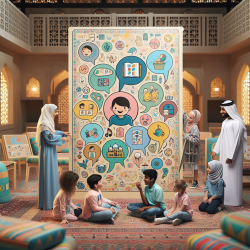The Picture Exchange Communication System (PECS) is a widely recognized method for developing communication skills in children with Autism Spectrum Disorder (ASD). However, most research on its efficacy has been conducted in Western contexts. A recent study titled "Comparative Study of the Perspectives on the Impact of a Culturally Responsive Picture Exchange Communication System for Children With Autism Spectrum Disorder in the United Arab Emirates" explores its effectiveness in a non-Western setting, specifically the UAE.This study is crucial for practitioners who aim to improve their skills and create better outcomes for children with ASD. Here are the key findings and recommendations for implementing PECS in a culturally responsive manner.
Key Findings
The study involved parents and practitioners working with children with ASD in three emirates of the UAE. The main findings are:
- Parents were generally more positive about the impact of PECS on their children compared to practitioners.
- Males demonstrated more favorable perceptions towards PECS than females.
- More years of experience supporting children with ASD correlated with more positive perceptions of PECS.
- Children who began using PECS at an older age (6 years or more) showed more appreciable development.
Recommendations for Practitioners
Based on these findings, here are some actionable recommendations for practitioners:
1. Continuous Training
Regular and comprehensive training programs should be developed for both parents and practitioners. This will ensure that everyone involved is proficient in using PECS and can provide consistent support to children with ASD.
2. Gender-Sensitive Approaches
Given the differences in perceptions based on gender, training programs should aim to build confidence and efficacy in both male and female practitioners and parents.
3. Experience Sharing
Experienced parents and practitioners should be encouraged to share their knowledge and strategies with less experienced ones. This can be facilitated through workshops, seminars, and peer mentoring programs.
4. Age-Specific Strategies
Tailor PECS interventions to be age-appropriate. While early intervention is generally recommended, older children may also benefit significantly from starting PECS at a later age.
5. Cultural Context
Ensure that PECS materials and training are culturally responsive. This means considering local customs, languages, and societal norms to make the system more relatable and effective for children in the UAE.
Conclusion
The study underscores the importance of culturally responsive approaches in the implementation of PECS for children with ASD in the UAE. By adopting these recommendations, practitioners can enhance the communication skills, learning abilities, and social interactions of children with ASD, leading to better outcomes.To read the original research paper, please follow this link:
Comparative Study of the Perspectives on the Impact of a Culturally Responsive Picture Exchange Communication System for Children With Autism Spectrum Disorder in the United Arab Emirates.










